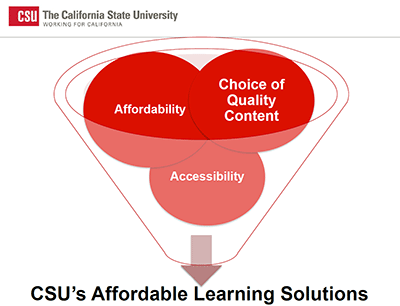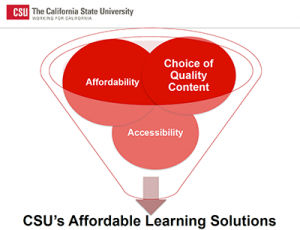

The three basics of the AL$ program are affordability, accessibility and choice of quality content. Image credit: Gerry Hanley.
The rising cost of tuition and textbooks have significantly impacted students’ learning behavior. In 2014, the independent student organization Student Public Interest Research Groups (PIRG) found that 65 percent of college students in the United States do not purchase course-required textbooks due to the expense. The consequences are unprepared students, bad grades and frustration within the classroom.
“When faculty choose textbooks, the last thing they think about is cost,” said Laurie Borchard, a librarian at California State University, Northridge’s Delmar T. Oviatt Library. “They take into to account if [the books] have been used before, if they are well known in the field and how effective they are. That makes sense, but a lot of courses have textbooks ranging anywhere between $50–150. And then you don’t get a lot of money to resell them.”
California State University campuses have advocated for the initiative for several years. The Chancellor’s Office grants up to $20,000 to different CSUs each year to promote affordable learning solutions. In spring 2015, Borchard applied for the AL$ grant for CSUN.
Borchard is the coordinator of the Affordable Learning Solutions (AL$) initiative at CSUN. She recently published the article Combating the Rising Cost of Education, which introduced the initiative to CSUN.
“The great thing about open educational resources and initiatives like this is the focus on adapting resources that already exist and are open and free to use, as well as utilizing library resources,” said Borchard.
The AL$ initiative cooperates with the Department of Academic Technology, the Faculty Technology Center, the Matador Bookstore and the Oviatt Library, helping students and faculty select free or affordable quality resources.
“The bookstore is centrally committed to maximizing student access to the materials needed for success,” said Amy Berger, director of the Matador Bookstore. “Price can be a major barrier for some students, so we strive to offer a wide range of affordable options.”
According to Berger, many students make use of the textbook rentals at the bookstore, which can save them up to 80 percent of the textbook costs. Therefore, the bookstore constantly tries to expand the inventory for the course textbooks at CSUN.
Berger also encourages faculty to explore alternatives on the internal online adoption tool, which provides quick access to low and no-cost course materials, such as YouTube videos, open educational resources (OER) and massive open online course (MOOC) content.
“The bookstore will continue to partner with faculty in exploring affordable course materials options,” Berger said. “Students will have more choices and affordable options to ensure they have access to what they need to succeed.”
Courses that use print textbooks can be redesigned for Moodle classes, including images, texts, tutorials and a combination of other digital learning materials. A redesign takes time, but will be financially covered.
“I think of that as being a more engaging and effective way of learning, because it covers different learning styles,” Borchard said.
But courses don’t necessarily have to be completely redesigned to be more affordable to students. The AL$ initiative also helps faculty create new texts or find new open sources, depending on their needs and course requirements.
“It definitely takes time and investment, but if you are able to talk with the people who have already done it, they all have really positive things to say about it,” Borchard said. “They all talk about how their students are prepared and more engaged in the class. It creates a better environment for everyone.”
The affordable learning solutions consist of three criteria: affordability, accessibility and the quality of content. Affordability is determined by choosing material that’s either free or low cost, while all the materials are carefully evaluated to ensure they meet the needs of students and course requirements.
For accessibility, the initiative places importance on resources for students with disabilities.
“As we’re assisting faculty with finding and evaluating resources, part of that evaluation is making sure that they are accessible,” Borchard said.
Organizers are looking for faculty who want to experiment with redesigning their course, she said. She encouraged all faculty members to reach out and learn about different solutions and possibilities from the AL$ initiative and the available grants.
“Moving forward, we would really like to educate faculty on open education resources and making their classes more affordable,” Borchard said. “I remember what it was like to be a student. I didn’t always purchase my textbooks because I couldn’t afford them.”
After learning about the initiative in a workshop, Borchard said, she was inspired by the program and what other CSU campuses were doing. She learned about the positive impact on student outcomes.
“This is really something that benefits the students in a lot of different ways,” Borchard said. “It promotes the idea that information should be free and available to everyone, especially in higher education. College is expensive enough, and we shouldn’t have these extra barriers of having to worry about affording the materials.”
Faculty interested in participating in the AL$ initiative can contact Laurie Borchard at (818) 677-4264 or laurie.borchard@csun.edu. For more information, visit the Affordable Learning Solutions website.